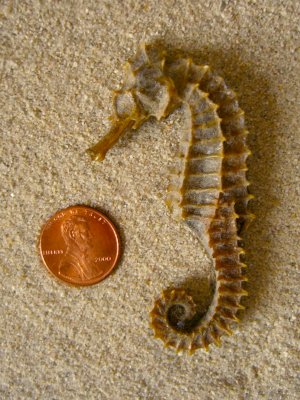
Seahorse

Seahorse
The Seahorse is one of the oddest creatures on earth. It is found in temperate and tropical waters around the world. It looks, of course, a little like a horse (with no legs and a curved lower body). Its scientific name is Hippocampus, two words derived from the Greek, and meaning “horse” and “sea monster.”
The Seahorse is actually a very slow-swimming fish, and is related to the pipefishes. It has almost invisible side fins, and swims in an upright position. Hippocampus has prominent eyes and independent eye movement. He can change colors, too; both that and independent eye movement are also characteristic of chameleons. He is the only fish possessing a prehensil, grasping tail. He often uses this flexible tail to hold on to seagrasses or coral. His body is covered in bony plates, giving him an “armored” look.
The Seahorse is toothless. Its gills, on each side of its head, resemble cheeks. He snaps the gills together to force water out of its mouth. Then he can open the gills very quickly, enabling him to suck in everything around him through his straw-like snout. If a bigger fish than he can swallow gets sucked to his mouth, the Seahorse just might suck a chunk out of the fish. Because the Seahorse is such an indiscriminate and voracious eater, and because his digestive system works quickly, some of the tiny animals he eats come out alive, only to be sucked in again. Brine shrimp are a favorite diet item — a young Seahorse can consume almost 3,500 baby brine shrimp in less than ten hours.
The female of the species deposits her eggs in a brood pouch on the ventral, or underside, of the male's tail, closer in to the “torso.” He raises the babies, providing the Seahorse eggs with oxygen, nutrients, and a nurturing environment overall. Strangely enough, the hormone prolactin (which stimulates milk production in human females) is produced by the “daddy” Seahorse. A Seahorse couple is monogamous, and may produce as many as 1000 babies per batch.
There are at least 37 species of this fish worldwide, but the genus is threatened because the unique creatures are harvested for use as food (!), keychains (!), and other curios and collectibles. At one time, the heads were cut off and mounted on a wooden base to be used as chess pieces, because the Seahorse resembles the Knight. Nowadays dead Seahorses are even embedded (with other seashells) in lucite toilet seats. Living Seahorses are popular fish for aquariums. The Seahorse is also used in pharmaceuticals.
One type of Seahorse, H. ingens, found in eastern Pacific waters, may grow to a “height” of 14 inches. (Seahorses are normally in a vertical posture.) H. bargilante, off the coast of New Calodonia, is a fraction of that size — 2/3 of an inch. H. erectus, found in shallow water from Cape Cod (and occasionally Nova Scotia) to Argentina and into the Gulf of Mexico, is about 5 inches. H. erectus is called the Lined Seahorse — he has a pattern of dark, irregular, broad lines on a lighter background.
The Seahorse motif is a favorite of artists. It is depicted on shower curtains, in framed prints, on stationery, etc. People all over the world seem enchanted by this myth-like creature.